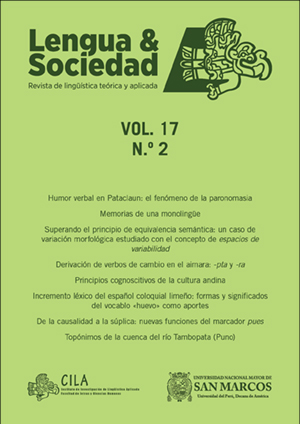Overcoming the requirement of semantic equivalence: a case of morphological variation studied with variability’s spaces concept
DOI:
https://doi.org/10.15381/lengsoc.v17i2.22352Keywords:
verbal tense, morphological variation, variable, Spanish, Lima, spaces of variabilityAbstract
From the field of sociolinguistics, this research studies a case of morphological variation, the use of imperfect and pluperfect subjunctive of Spanish (-ra/-se), through the concept of variability’s spaces postulated by Caravedo (1991, 2014), wich overcames the sociolinguistic variable’s requirement of semantic equivalence. The sample is formed by 54 Spanish speakers born in Lima with university education. The phenomenon is investigated in order to determine if the variant -ra is displacing the variant -se. In the same way, it is intended to know if the choice of one form or another is statistically conditioned by the verbal tense. It is concluded that the use of -ra exceeds the use of -se in the sample studied. Likewise, verbal tense was shown as a statistically significant variable: simple tense is related to the use of -ra and compound tense, with -se.
References
Alvar, M., & Pottier, B. (1983). Morfología histórica del español. Madrid: Gredos.
Asratián, A. (2007). Variación -ra/-se en el español hablado en Caracas. Boletín de Lingüística, 19(27), 5-41. Recuperado de http://www.scielo.org.ve/scielo.php?pid=S0798-97092007000100001&script=sci_arttext.
Blas, J., & Porcar, M. (1994). Empleo de las formas -ra y -se en las comunidades de habla castellonenses. Aproximación sociolingüística. Español actual. Revista de español vivo, 62, 73-98.
Caravedo, R. (1987). Reseña de Variación y significado. Filología, 22(1), 207-212.
Caravedo, R. (1991). Los espacios de variabilidad en fonología. Voz y Letra. Revista de Filología, 2(1), 17-38.
Caravedo, R. (2014). Percepción y variación lingüística. Enfoque sociocognitivo. Madrid/Frankfurt: Iberoamericana/Vervuert.
Cuba, M. (1996). El castellano hablado en Chincha. Lima: Escuela de Postgrado UNMSM.
DeMello, G. (1993). -ra Vs. -se subjunctive: a new look at an old topic. Hispania, 76(2), 235-244.
Fleishman, S. (1989). A basic linguistic metaphor. Studies in language, 13(1), 1-50.
Labov, W. (1978). Where does the linguistic variable stop? A response to Beatriz Lavandera. Working papers in Sociolinguistics, 44, 6-23.
Labov, W. (1983 [1972]). Modelos sociolingüísticos. Madrid: Cátedra.
Lamíquiz, V. (1971). Cantara y cantase. Revista de filología española, 54, 1-11. Recuperado de http://xn--revistadefilologiaespaola-uoc.revistas.csic.es/index.php/rfe/article/view/864/1271
Lavandera, B. (1984 [1978 y 1979]). Variación y significado. Buenos Aires: Hachette.
Navarro, M. (1990). La alternancia -ra/-se y -ra/-ría en el habla de Valencia (Venezuela). Thesaurus, 45(2), 481-488. Recuperado de http://cvc.cervantes.es/lengua/thesaurus/pdf/45/th_45_002_177_0.pdf
Real Academia Española. (2009). Nueva gramática de la lengua española. Morfología y Sintaxis. Madrid: Espasa.
Samamé, A. (2018). ¿Cantara o cantase?: un estudio sociolingüístico del imperfecto y pluscuamperfecto del subjuntivo en hablantes limeños con grado de instrucción superior (Tesis para optar el grado académico de Magíster en Lingüística). Pontificia Universidad Católica del Perú, Lima.
Serrano, M. (1996). El subjuntivo -ra y -se en oraciones condicionales. Estudios filológicos, 31, 129-140.
Williams, A. (1982). The use of -ra and -se Forms of the past subjunctive in Navarre. Hispania, 65(1), 89-93.
Wrigth, L. (1926). The subjunctive forms in -ra and -se in Spanish-American Speech. Hispania, 9(3), 170-173.
Downloads
Published
Issue
Section
License
Copyright (c) 2018 Anahís Samamé Rispa

This work is licensed under a Creative Commons Attribution 4.0 International License.
AUTHORS RETAIN THEIR RIGHTS
a. Authors retain their trade mark rights and patent, and also on any process or procedure described in the article.
b. Authors can submit to the journal Lengua y Sociedad, papers disseminated as pre-print in repositories. This should be made known in the cover letter.
c. Authors retain their right to share, copy, distribute, perform and publicly communicate their article (eg, to place their article in an institutional repository or publish it in a book), with an acknowledgment of its initial publication in the journal Lengua y Sociedad.
d. Authors retain theirs right to make a subsequent publication of their work, to use the article or any part thereof (eg a compilation of his papers, lecture notes, thesis, or a book), always indicating its initial publication in the journal Lengua y Sociedad (the originator of the work, journal, volume, number and date).



























